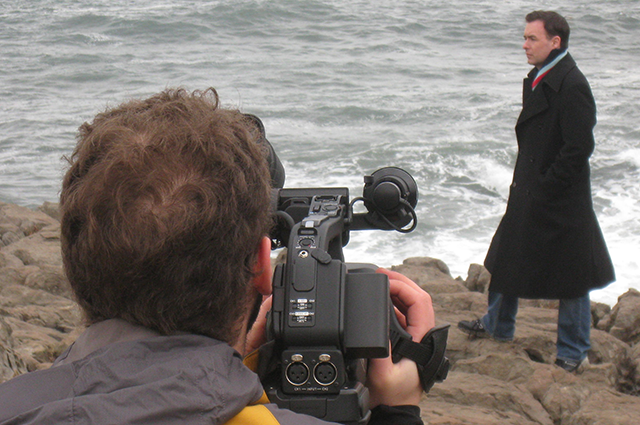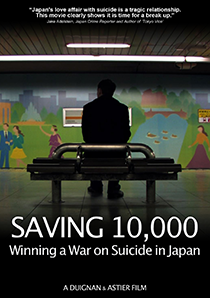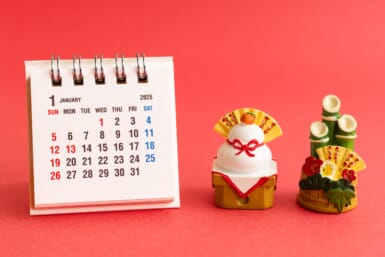More than a year after Dr. Rene Duignan declared a war against suicide in Japan, the hard-fought battle is still going strong with no signs of its momentum slowing down.
By Sami Kawahara
With nearly 300,000 views on YouTube in 9 months and more than 93 screenings and interviews across Japan since its first release in September 2012, Saving 10,000, the documentary that Dr. Duignan created alongside a former student has created a buzz so strong that it has made its way up to the parliament. The Weekender caught up with Dr. Duignan to discuss the reactions of the public and the experiences he’s encountered along the way.
“They want to talk, that is the simple truth,” Dr. Duignan observes after hosting a year’s worth of screenings and events.
“It attracts a lot of people that have considered or are considering suicide, and I always seem to find myself having a conversation with someone after an event where I know, and they know, that I’m trying to convince them not to kill themselves. And I can tell that’s happening by instinct now.”
Although Dr. Duignan is not professionally trained in counseling suicidal people, the work has become a part of his daily life through his years of extensive research in the field and his personal experiences. Dr. Duignan says with him, people aren’t just talking about their specific problems when they meet him after a screening.
“They are more debating with me that killing yourself is not such a bad thing. It can be justifiable, it can be rational. So I’m not saying to them you know, ‘that relationship will get better,’ I am saying, ‘no it is never a rational action, it is never good and the damage that it causes to the people around you is permanent.’”
Saving 10,000 Lives, the documentary sparked by Dr. Duignan’s deep regret of not speaking or listening more to his neighbor who eventually committed suicide, investigates the forces behind the high suicide rate in Japan.
Whether it’s social pressure, flaws in the healthcare system, or financial stress, Dr. Duignan understands that we, as ordinary people, can only do so much. However, the one thing he highlights in both the documentary and more than a year later is the importance of listening.
Dr. Duignan created this documentary for a very specific purpose, but the attention the film has received is beyond what he ever imagined. Saving 10,000 Lives has been entered into international film festivals around the world and received numerous awards from various organizations. Even with easy access to the film online, groups are still organizing screenings and events to watch this documentary together. People want to discuss after, according to Dr. Duignan, and it has really “developed its own life now. It’s being screened and people are talking about it. People have gone to heroic lengths to spread it.”
The documentary has indeed made people aware of the root of the problems, but the life it has taken on has highlighted other issues as well. In fact, an insight Dr. Duignan had a few days before our conversation was the influence and importance of speaking to the people around us, especially in Japan. “If we look from above at this issue, we will see that most people who have these difficulties will never actually get professional help. They would never go that far to go get help. So that must mean they must get through [their issues] with the people around them. And the fact that Japanese people are reluctant to either talk or listen to the people around them is a problem.”
From the perspective of the Japanese community and foreigners living in Tokyo, Dr. Duignan emphasizes that “it really does come down to the fact of listening a little bit more to people, or talking to people when you are experiencing difficulties yourself—and maybe for those of us who have the opportunity to listen, to look of that as a positive thing and not look at it as a nuisance. That you can help people and you can stop things from escalating.”
Dr. Duignan calls the volunteers of the Tokyo English lifeline, TELL, the true heroes of this battle. “So many foreigners are manning those phone lines, they have their training, and the concept that people are going in and doing that is amazing to me. Quite frankly, it’s a lot harder than making a movie: going in there and listening to those calls and really helping people in a practicable way.” TELL is a great means for us to help as it is an active resource for both foreigners and locals. Although it is an English lifeline, 60% of callers are Japanese, possibly indicating an overwhelming need for help from the Japanese community.
Even though Dr. Duignan and his supporters have already seemed to have made a big impact so far, with the suicide rate dropping below 30,000 in 2012 for the first time in 15 years, the end of this push is nowhere in sight.
“I still feel there’s that feeling of regret driving me on, I still don’t feel it’s enough,” Dr. Duignan says.
“This is a marathon not a sprint. We have to keep this thing going.”
Saving 10,000 Lives by the numbers:
- More than 300,000 people (equal to the population of Iceland) have killed themselves in Japan in the past 10 years.
- The suicide rate in Japan is 2x higher than the US
- 1/3 of all suicides in Japan are people more than 60 years old
- 40% of people who attempt to commit suicide by jumping in front of a train survive with critical injuries
- It costs a train line approximately $700,000 when a suicide is committed due to commuters switching lines
- A train company charges approximately $60,000 to the family of the person who committed suicide
- 10–20% of patience in ER are suicide attempts
- In the psychiatric healthcare system, it is estimated that psychiatrists have approximately 3-4 minutes to spend with their patients
- Tōjinbō Cliff, a popular “tourist spot” known for suicides, has been the location for 646 suicides in the past 30 years.
- A former police officer dedicated to saving people’s lives at the cliff has saved 297 lives in 6 years and 7 months just by talking to them. Only four people have gone through with it after.
Learn more about Saving 10,000 here










